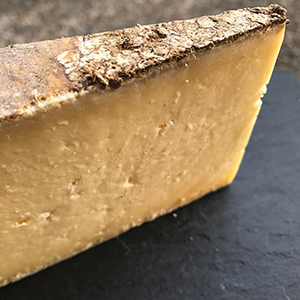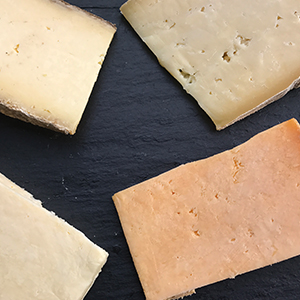To fully appreciate one of Britain’s finest treasures, it helps to have an education on its background and history.
British Crumblies refer to a subsection of British Territorial Cheeses. In brief, these are cheeses that are named after the county or area in which they are from. This group of cheeses have been coined the term ‘crumblies’ due to their texture, which distinguishes them from the harder cheeses within the territorials.

In the cheesemaking process of crumblies, their drainage is a slower procedure and, in turn, decalcifies the cheeses more, making their texture more crumbly than the quicker draining Cheddar recipe.
It’s interesting to note that all cheese recipes would have been slow-draining before commercial starters were introduced. The distinction lies in the fact that the Cheddar recipe, which produces a more robust curd, can be modified for industrial scale without completely losing its identity, whereas the same can’t be said of the Crumblies. They need more delicate handling to preserve the final texture, as this comes from allowing the milk to do what it does naturally.
The Lancashire recipe is unlike the more acidic Cheshire, Wensleydale and Caerphilly, as it uses very small quantities of starter and its acidity comes from allowing curd to keep developing for an extra day or two before salting. Its crumble also owes much to breaking up the curd several times once it has been removed from the vat to a draining table.
The Crumblies mainly originate from the North of England and Wales. Nowadays, however, these historical cheeses on an industrial scale have migrated slightly, and their borders have become a little less defined than in the past.
The term typically refers to four main cheeses, which are Cheshire, Wensleydale, Lancashire and Caerphilly. To fully understand Crumblies, it helps to be familiar with each type.
Here, we’ve provided a rundown of each type, including the region of origin, history and distinct qualities. All British Crumblies have a uniqueness that warrants seeking them out.
Cheshire
Cheshire is Britain’s oldest named cheese, being mentioned in the Domesday Book. It was made originally in the northwest of England in Cheshire and its surrounding areas. From the 16th century, this area would have included Shropshire, Staffordshire, Warwickshire and parts of Clwyd in North Wales.
Cheshire is well known for its ‘terroir’, many believing that its distinct flavor is due to this.

In 1900, there were more than 2,000 farms making Cheshire; by 1939, there were just over 400. World War II brought it down to 40. There are still a number of farmhouse Cheshire producers; however, only the Appleby family still makes a raw milk cheese. Now, most Cheshire is made in creameries, which are designed to manufacture many types of English territorial cheeses and are not area specific.
In flavor and aroma, Cheshire is clean, mild, acidic and fresh. Its texture is firm with an open, crumbly paste. It should be bright white in color, unless it is intentionally colored like Appleby’s Cheshire. In this instance, annatto is used. Cheshire is sold and best eaten at around the three-month mark. It is traditionally eaten alone or it can be served with fruitcake, figs or dates that have a sweetness complemented by the tart acidity of the cheese.
Wensleydale
Wensleydale also is an incredibly old recipe dating back to the Norman Conquest of England. From this, monasteries were built for Cistercian monks in the Yorkshire Dales, and they brought over their cheesemaking skills. The local animals of the area at the time were sheep, so Wensleydale in fact started its journey as a sheep’s milk cheese. It was also naturally blue.
The dissolution of the monasteries in the 16th century led to the cheesemaking being passed down to local farmers. In Wensleydale, this process was continued in the same manner until the 17th century, when cow’s milk started to replace sheep’s milk in the area.
The bright white, clean-looking, modern day Wensleydale was only introduced in the mid 20th century, and a large amount of the industrial version is made outside of Yorkshire. However, the Wensleydale Creamery now owns a PGI of ‘Yorkshire Wensleydale’, guaranteeing it is from Yorkshire.
Many modern flavor-added Wensleydales also have been created to appeal to a new market. These include the more popular Wensleydale with Cranberries all the way to one I saw in July with Raspberry and Prosecco. Wensleydale should be clean, mildly acidic and fairly dry with a flaky texture.
Lancashire
Lancashire is originally from the County of Lancashire in the northwest of England. The length of time it takes to produce traditional Lancashire is an incredibly long and laborious process. The cheese differs from others in that its make consists of more than one day’s worth of milking and combines curd from more than one day.
This process is seen as definitive of the farmhouse Lancashire cheese recipe, but these steps actually came to fruition because the majority of cheesemakers would have only owned a small amount of cows and, therefore, not produced enough milk in one day to make a whole cheese. Some farms would use up to three days worth of curds.
The curd was scooped into cloth-lined tubs, pressed and cut, broken up and recut several times. It would then have the previous days’ curd added to it or, if at the beginning of the process, it would be left and stored to be mixed with the following day’s curd. Those two or three days of curd would be salted and milled together to become the finished cheeses.

Over the course of the 20th century, the cheese has been adapted for factory production and is now made on a range of scales from farmhouse to industrial. When industrializing, as became the fate of many English cheeses, this long process was changed so recipe modifications were made and the process was sped up. This, in turn, created a different cheese, which most knew and still know as Lancashire with so many still not even knowing or having tasted the farmhouse version.
This cheese, which is eaten at a younger age, is known as ‘Crumbly’ Lancashire, whereas the more aged, traditional cheeses are known as ‘Creamy/Tasty’ Lancashire. Graham Kirkham is now the only cheesemaker making unpasteurized Lancashire cheese at his Beesley Farm in Goosnargh.
Lancashire is aged anywhere from four to nine months and, in some cases, up to a year. It has a smooth and buttery texture, a friable paste with yogurt notes and a distinct aroma of lemon. A few years back, I was speaking to Kirkham’s who told me that there is a local saying about pairing ideas. “Apple pie without Lancashire Cheese is like a kiss without a squeeze!”
Caerphilly
Caerphilly originated in Caerphilly, north of Cardiff in Wales. It is a newer cheese than the above three, dating back to the early 19th century.
Caerphilly came to life as a cheese due to the excess of milk on the dairy farm. It soon became popular and, by 1830, the demand was so high that farmers were actively keeping aside milk for its production instead of just using their surplus.
The recipe spread to Somerset, where farmers started to make it as an alternative to Cheddar. Its appeal lay in the fact that it took a lot less time to make, age and turn over. As with all three cheeses above, traditional Caerphilly was hit by industrialization, and those making farmhouse cheeses declined rapidly. By the 1950s only one farm, Ducketts in Wedmore, was making farmhouse Caerphilly.
Chris Duckett moved to Westcombe Farm in Somerset, passed on the recipe, and it is still made there today. Chris Duckett also passed his knowledge on to Todd Trethowan, who started Gorwydd Caerphilly in Wales. Caerphilly should be clean, milky and acidic, with citric lemony notes and fresh milky flavors.
As well as enjoying these cheeses the way they were intended, they make for delicious ingredients in recipes, such as the one on page 31 from the Appleby family, who make Appleby’s Cheshire.
APPLEBY’S CHESHIRE AND FRESH HERB SCONES

Makes 12
Ingredients:
1 cup plain flour, plus extra for dusting
3 tsp baking powder
A pinch of salt
¼ tsp cayenne pepper
3 ¼ Tbsp unsalted butter, chilled and cut into cubes
¼ cup Appleby’s Cheshire, grated
1 Tbsp of your selection of chopped fresh herbs
½ cup milk, plus extra for brushing
To serve:
Unsalted butter, softened
Sift the flour, baking powder, salt and cayenne pepper into a large bowl. Rub in the butter with your fingertips until the mixture looks like fine bread crumbs, then stir in the cheese and the fresh herbs.
Gradually add the milk and mix to form a soft, but not sticky, dough.
Turn out onto a lightly-floured surface and pat out to about ¾ inches thick.
Dip the cutter in flour and press out as many rounds as possible. Gather the trimmings, pat out again and cut out more rounds
Put the scones well apart on the baking sheet, and brush the tops with milk.
Bake in a preheated oven (400 degrees F) for about 12-15 minutes until risen and golden.
Serve warm or let cool on a wire rack.



